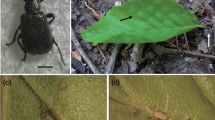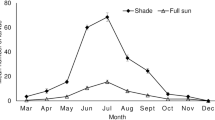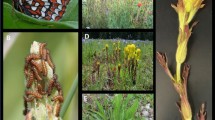Abstract
The shapes of plant leaves are remarkably diverse, but their ecological functions are largely unknown. Reports on the effects of leaf shape on biotic interactions such as herbivory are especially scarce, partly because herbivorous insects rarely rely on leaf shape for host selection. Here, we show that leaf shape acts as a physical deterrent against a leaf-processing herbivore. Plants in the genus Isodon (Lamiaceae) host a specialized leaf-rolling weevil (Apoderus praecellens) whose ovipositing females process an entire leaf into a leaf roll to serve as larval food and shelter. Among the species of Isodon, I. umbrosus var. hakusanensis is exceptional in that it has deeply lobed leaves. Because leaf processing follows a consistent sequence of complex behaviours, the unusual shape of I. umbrosus leaves may disrupt this process. Under both natural and laboratory conditions, female weevils preferred I. trichocarpus, a close relative with non-lobed leaves, over I. umbrosus. Nutritional properties of the leaves do not explain this preference because weevil larvae developed equally well on both hosts. Modifying the non-lobed I. trichocarpus leaves to mimic the shape of I. umbrosus leaves also discouraged leaf processing. Leaf processing often terminated because weevils failed to complete the inspection routine on I. umbrosus leaves. Leaf shape may be an important but overlooked factor that affects the interactions between plants and leaf-processing herbivores.
This is a preview of subscription content, access via your institution
Access options
Access Nature and 54 other Nature Portfolio journals
Get Nature+, our best-value online-access subscription
$29.99 / 30 days
cancel any time
Subscribe to this journal
Receive 12 digital issues and online access to articles
$119.00 per year
only $9.92 per issue
Buy this article
- Purchase on Springer Link
- Instant access to full article PDF
Prices may be subject to local taxes which are calculated during checkout



Similar content being viewed by others
Data availability
The data that support the findings of this study are available from the corresponding author on request.
References
Givnish, T. J. in Topics in Plant Population Biology (eds Solbrig, O. T. et al.) 375–407 (Macmillan, 1979).
Nicotra, A. B. et al. The evolution and functional significance of leaf shape in the angiosperms. Funct. Plant Biol. 38, 535–552 (2011).
Kidner, C. A. & Umbreen, S. Why is leaf shape so variable? Int. J. Plant Dev. Biol. 4, 64–75 (2010).
Brown, V. K. & Lawton, J. H. Herbivory and the evolution of leaf size and shape. Philos. Trans. R. Soc. Lond. B 333, 265–272 (1991).
Berneys, E. A. & Chapman, R. F. Host-Plant Selection by Phytophagous Insects (Chapman and Hall, 1994).
Prokopy, R. J. & Owens, E. D. Visual detection of plants by herbivorous insects. Annu. Rev. Entomol. 28, 337–364 (1983).
Rausher, M. D. Search image for leaf shape in a butterfly. Science 200, 1071–1073 (1978).
Gilbert, L. E. The coevolution of a butterfly and a vine. Sci. Am. 247, 110–121 (1982).
Dell’Aglio, D. D., Losada, M. E. & Jiggins, C. D. Butterfly learning and the diversification of plant leaf shape. Front. Ecol. Evol. 4, 1–7 (2016).
Murata, G. & Yamazaki, T. in Flora of Japan vol. IIIa (eds Iwatsuki, K. et al.) 309–314 (Kodansha, 1993).
Uéhara, C. & Suzuki, K. Host plants of the Subfamilies Apoderinae and Attelabinae (Coleoptera, Attelabidae) in the Chûbu District, Central Honshu, Japan. Res. Rep. Toyama Sci. Mus. 21, 77–97 (1998).
Mclellan, T. & Endler, J. A. The relative success of some methods for measuring and describing the shape of complex objects. Syst. Biol. 47, 264–281 (1998).
Sakurai, K. Leaf size recognition and evaluation of some Attelabid weevils (2) Apoderus balteatus. Behaviour 106, 301–317 (1988).
Sisó, S., Camarero, J. J. & Gil-Pelegrín, E. Relationship between hydraulic resistance and leaf morphology in broadleaf Quercus species: a new interpretation of leaf lobation. Trees 15, 341–345 (2001).
Zwieniecki, M. A., Boyce, C. K. & Holbrook, N. M. Hydraulic limitations imposed by crown placement determine final size and shape of Quercus rubra L. leaves. Plant Cell Environ. 27, 357–365 (2004).
Vogel, S. Convective cooling at low airspeeds and the shapes of broad leaves. J. Exp. Bot. 21, 91–101 (1970).
Leigh, A., Sevanto, S., Close, J. D. & Nicotra, A. B. The influence of leaf size and shape on leaf thermal dynamics: does theory hold up under natural conditions? Plant Cell Environ. 40, 237–248 (2017).
Gianoli., E. & Carrasco-Urra, F. Leaf mimicry in a climbing plant protects against herbivory. Curr. Biol. 24, 984–987 (2014).
Niemelä, P. & Tuomi, J. Does the leaf morphology of some plants mimic caterpillar damage? Oikos 50, 256–257 (1987).
Fukui, A. Indirect interactions mediated by leaf shelter in animal-plant communities. Pop. Ecol. 43, 31–40 (2001).
Vieira, C. & Romero, G. Q. Ecosystem engineers on plants: indirect facilitation of arthropod communities by leaf-rollers at different scales. Ecology 94, 1510–1518 (2013).
Cornelissen, T., Cintra, F. & Santos, J. C. Shelter-building insects and their role as ecosystem engineers. Neotrop. Entomol. 45, 1–12 (2016).
Harris, M. O. & Miller, J. R. Foliar form influences ovipositional behavior of the onion fly. Physiol. Entomol. 9, 145–155 (1984).
Howlett, B. G. & Clarke, A. R. Role of foliar chemistry versus leaf-tip morphology in egg-batch placement by Chrysophtharta bimaculate (Olivier) (Coleoptera: Chrysomelidae). Aust. J. Entmol. 42, 144–148 (2003).
Abràmoff, M. D., Magalhães, P. J. & Ram, S. J. Image processing with ImageJ. Biophoton. Int. 11, 36–42 (2004).
R Core Development Team R: A Language and Environment for Statistical Computing (R Foundation for Statistical Computing, 2018).
Acknowledgements
We thank S. Sakai and K. Mochizuki for helpful suggestions throughout the course of the study and W. Toki, R. Nakadai, S. Furukawa, K. Takeda, J. Li and I. Kamata for discussion. K. Mochizuki, S. Furukawa, K. Takeda, J. Li and I. Kamata helped collect materials and data. S. Sakai, K. Koba and T. Muranaka provided comments that improved the manuscript. This work was supported by a Grant-in-Aid for JSPS Fellows (grant no. 18J12748), a grant from the Fujiwara Natural History Foundation to Y.H. and a Grant-in-Aid for Scientific Research (B) to A.K. (grant no. 15H04421).
Author information
Authors and Affiliations
Contributions
Y.H. and A.K. designed the research. Y.H. performed the research and analysed the data. Y.H. and A.K. wrote the paper.
Corresponding author
Ethics declarations
Competing interests
The authors declare no competing interests.
Additional information
Peer review information: Nature Plants thanks Thomas Givnish and the other, anonymous, reviewer(s) for their contribution to the peer review of this work.
Publisher’s note: Springer Nature remains neutral with regard to jurisdictional claims in published maps and institutional affiliations.
Supplementary information
Supplementary Information
Supplementary Fig. 1 and Tables 1–3.
Supplementary Video 1
Surveying behaviours of female A. praecellens on leaves of I. trichocarpus.
Supplementary Video 2
Surveying behaviours of female A. praecellens on leaves of I. umbrosus var. hakusanensis.
Supplementary Video 3
Rolling behaviour of a female A. praecellens on a leaf of I. umbrosus var. hakusanensis.
Rights and permissions
About this article
Cite this article
Higuchi, Y., Kawakita, A. Leaf shape deters plant processing by an herbivorous weevil. Nat. Plants 5, 959–964 (2019). https://doi.org/10.1038/s41477-019-0505-x
Received:
Accepted:
Published:
Issue Date:
DOI: https://doi.org/10.1038/s41477-019-0505-x
This article is cited by
-
PpSCARECROW1 (PpSCR1) regulates leaf blade and mid-vein development in Physcomitrium patens
Plant Molecular Biology (2024)
-
Ecosystem engineering and leaf quality together affect arthropod community structure and diversity on white oak (Quercus alba L.)
Oecologia (2023)
-
The functional microbiota of on- and off-year moso bamboo (Phyllostachys edulis) influences the development of the bamboo pest Pantana phyllostachysae
BMC Plant Biology (2022)
-
Effects of forest fragmentation on plant quality, leaf morphology and herbivory of Quercus deserticola: is fluctuating asymmetry a good indicator of environmental stress?
Trees (2022)



